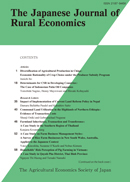Volume 11
Displaying 1-3 of 3 articles from this issue
- |<
- <
- 1
- >
- >|
Article
-
2009Volume 11 Pages 1-8
Published: March 31, 2009
Released on J-STAGE: November 30, 2015
Download PDF (181K) -
2009Volume 11 Pages 9-32
Published: March 31, 2009
Released on J-STAGE: November 30, 2015
Download PDF (1059K)
Research Trends
-
2009Volume 11 Pages 33-46
Published: March 31, 2009
Released on J-STAGE: November 30, 2015
Download PDF (395K)
- |<
- <
- 1
- >
- >|
